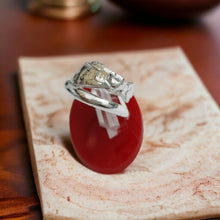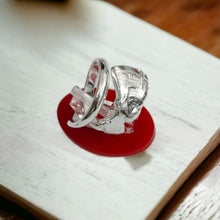
The Silver Egyptian Queen Nefertiti Adjustable Ring: A symbol of timeless elegance, inspired by the iconic beauty of Queen Nefertiti, an ancient Egyptian queen renowned for her grace and power. This adjustable ring captures her essence in sterling silver, blending history with modern style.
- History: Inspired by Queen Nefertiti, a symbol of ancient Egyptian beauty and power.
- Spirituality: Evokes the mystique of ancient Egyptian spirituality and reverence for royalty.
- Talisman: Carries the energy of Nefertiti, believed to bring strength and confidence.
- Handmade: Crafted with care, each piece unique, reflecting artisanal skill and attention to detail.
- Healing: Thought to channel the regal energy of Nefertiti for inner strength and resilience.
- Material: Sterling silver, known for its purity and connection to the moon, enhancing intuition.
- Symbolism: Represents beauty, power, and feminine strength, echoing Nefertiti's legacy.
- How to Wear: Adjust the ring to fit comfortably, allowing its energy to adorn your finger gracefully.
History Side For Those Who Are Interested
Nefertiti, whose name means "the beautiful one has come," is one of ancient Egypt's most renowned queens, celebrated for her beauty, influence, and role during the tumultuous period of the 18th Dynasty. While her exact lineage and early life remain shrouded in mystery, historical records suggest she was born around 1370 BCE during the reign of Pharaoh Amenhotep III.
Nefertiti's significance in Egyptian history primarily stems from her marriage to Amenhotep IV, later known as Akhenaten, who ascended to the throne around 1353 BCE. Akhenaten initiated a religious revolution, elevating the sun god Aten as the supreme deity and promoting a monotheistic cult centered around him, known as Atenism. Nefertiti played a central role in this religious transformation, often depicted alongside Akhenaten in worship of Aten.
During their reign, Nefertiti's influence extended beyond her religious duties. She held unprecedented power and was depicted in art and inscriptions in a manner typically reserved for pharaohs. Some scholars even suggest that she may have ruled alongside Akhenaten as an equal, although evidence for this remains speculative.
One of the most iconic depictions of Nefertiti is the famous bust discovered in 1912 by the German archaeologist Ludwig Borchardt in Amarna, the capital city established by Akhenaten. This limestone bust, renowned for its exquisite craftsmanship and striking beauty, has become an enduring symbol of ancient Egypt and is now housed in the Neues Museum in Berlin.
Despite her prominence during Akhenaten's reign, Nefertiti's fate remains a subject of debate among historians. Some theories suggest that she outlived Akhenaten and possibly ruled as a regent for her young son, Tutankhamun, following Akhenaten's death. Others propose that she disappeared from historical records after Akhenaten's reign, possibly falling out of favor or dying prematurely.
The exact circumstances of Nefertiti's death and her later years continue to elude historians, contributing to her enigmatic legacy. Nevertheless, her impact on ancient Egyptian history and culture, both as a powerful queen and a religious figure, remains indelible, ensuring her place as one of antiquity's most captivating figures.

















